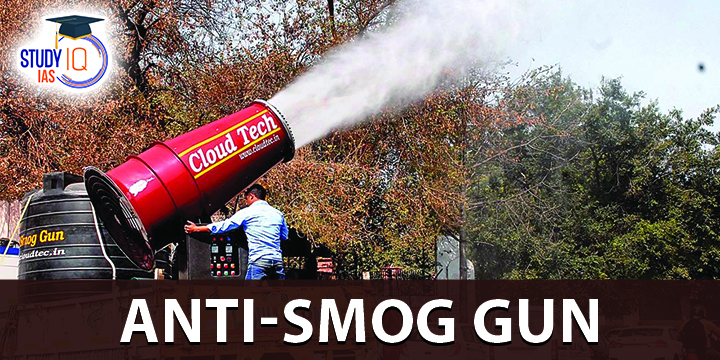Table of Contents
Anti Smog Gun in Delhi
Anti Smog Gun is an atomised water spraying device that can reduce air pollution in the atmosphere.
Anti Smog Gun Uses:
Construction sites: Previously, only large construction sites were required to use anti-smog gun, but now they have been mandated at smaller construction sites.
Road: Vehicle-mounted smog guns have been used to spray fine mist in an effort to get suspended dust settle.
Buildings: Smog guns are being placed atop buildings of around 7-10 storeys.
Working: The idea behind working of anti-smog guns is that water molecules sprayed into the atmosphere bind dust particles, forcing them to settle down on the ground.

Anti Smog Gun Uses
- Particulate dust settling: In winters, there is not enough humidity to settle dust particles. The anti-smog guns allow particulate matter to settle. However, it is not a permanent solution.
- It can be used locally when there is fire or construction and demolition dust. It cannot be effective for whole city.
- Smaller area: Anti Smog Guns can target only a small area and not the whole sky above the city. For the whole city, events like rain can reduce smog.
- Countries like China have used artificial rains to control haze but it can only be deployed at a larger scale and not concentrated areas.
- Use at source: Instead of firing the anti-smog guns at random sites, there are suggestions to use them at source sites such as traffic junctions and construction sites.
- However, there is no conclusive evidence to show its success due to lack of research.
- Moving suspended particles: Particles suspended in the air due to crop residue burning originate over surrounding areas and are brought to the city by winds. Reducing these particles using anti-smog guns is challenging.
Anti Smog Gun: Pollution in Delhi
Reasons for Pollution During Winters:
- Localized emissions: Majority of pollution in Delhi is caused due to industrial exhaust, burning of municipal waste, vehicular emission and construction waste. These add upto 80% of pollution source in the city and neighbouring areas.
- Inland winds: Winds flowing from coasts to the inland bring dust particles that hit the Himalayas and get trapped. This accumulates over northern plains, including Delhi.
- Low humidity: During winter, the region witnesses low levels of humidity. In absence of humidity, particulate matter keeps floating in the atmosphere without settling down.
- Trapping of cold air: Cooler air descends towards the ground during winter and warm air rises above it, acting as a lid. The cold air traps dust and associated particles to form smog.
Alternative ways to Control Pollution:
- Clean mobility: Clean mobility solutions such as electric vehicles and CNGs have to be promoted as majority of pollutants are vehicular emissions.
- Solutions to industrial emissions: Industrial emissions must be reduced by mandating scrubbers, absorbers and precipitators.
- Alternatives to stubble burning: Farmers have to be incentivized to give up stubble burning. Machines such as happy seeders can reduce instances of burning in agrarian regions.



 Daily Quiz 03 July 2025
Daily Quiz 03 July 2025
 Dalai Lama Confirms He will have a Succe...
Dalai Lama Confirms He will have a Succe...
 List of Awards and Honours Received by N...
List of Awards and Honours Received by N...





















